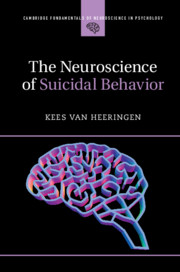Book contents
- Frontmatter
- Dedication
- Contents
- Figures
- Tables
- Preface
- Chapter One What Is Suicidal Behavior, and Can It Be Prevented?
- Chapter Two Stress, Vulnerability, and Suicide
- Chapter Three The Dark Side of the Brain
- Chapter Four Lethal Signals
- Chapter Five I Think, Therefore I Do Not Want to Be
- Chapter Six Images of the Suicidal Brain
- Chapter Seven “In my end is my beginning”
- Chapter Eight I Predict, Therefore I Cannot Be
- Chapter Nine Predicting the Unpredictable
- Chapter Ten The Treatment of Suicide Risk
- Glossary
- References
- Index
- Colour Plates
Chapter Seven - “In my end is my beginning”
A Neurodevelopmental Perspective on Suicidal Behavior*
Published online by Cambridge University Press: 22 May 2019
- Frontmatter
- Dedication
- Contents
- Figures
- Tables
- Preface
- Chapter One What Is Suicidal Behavior, and Can It Be Prevented?
- Chapter Two Stress, Vulnerability, and Suicide
- Chapter Three The Dark Side of the Brain
- Chapter Four Lethal Signals
- Chapter Five I Think, Therefore I Do Not Want to Be
- Chapter Six Images of the Suicidal Brain
- Chapter Seven “In my end is my beginning”
- Chapter Eight I Predict, Therefore I Cannot Be
- Chapter Nine Predicting the Unpredictable
- Chapter Ten The Treatment of Suicide Risk
- Glossary
- References
- Index
- Colour Plates
Summary
Children who have experienced sexual or physical abuse during childhood are at increased risk of suicidal behavior in adulthood, independent of other factors such as depression. Recent neurobiological studies target the mechanisms that link childhood abuse and suicidal behavior in adulthood. How does early-life adversity influence behavioral reactions to stressors much later in life to such an extent that people take their own lives? It is now becoming clear that early-life adversity increases the risk of suicide by influencing the development of stable emotional, behavioral and cognitive characteristics that confer a specific vulnerability. There is now considerable evidence that changes in the expression of particular genes constitute the molecular basis of this vulnerability. This chapter will review recent findings from genetic studies of suicidal behavior, with a particular focus on epigenetic regulation of the hypothalamic–pituitary–adrenal axis and other systems involved in responses to stress and on transcriptional changes in association with early-life adversity. It appears that such changes may become manifest as cognitive impairments that are commonly found in association with suicidal behavior, and that may be due to structural and functional alterations in the brain.
Keywords
- Type
- Chapter
- Information
- The Neuroscience of Suicidal Behavior , pp. 125 - 145Publisher: Cambridge University PressPrint publication year: 2018



